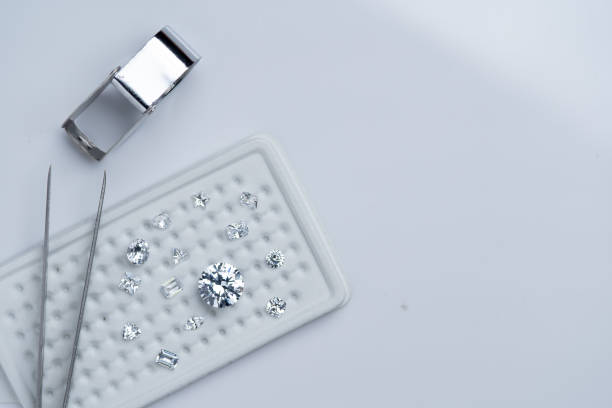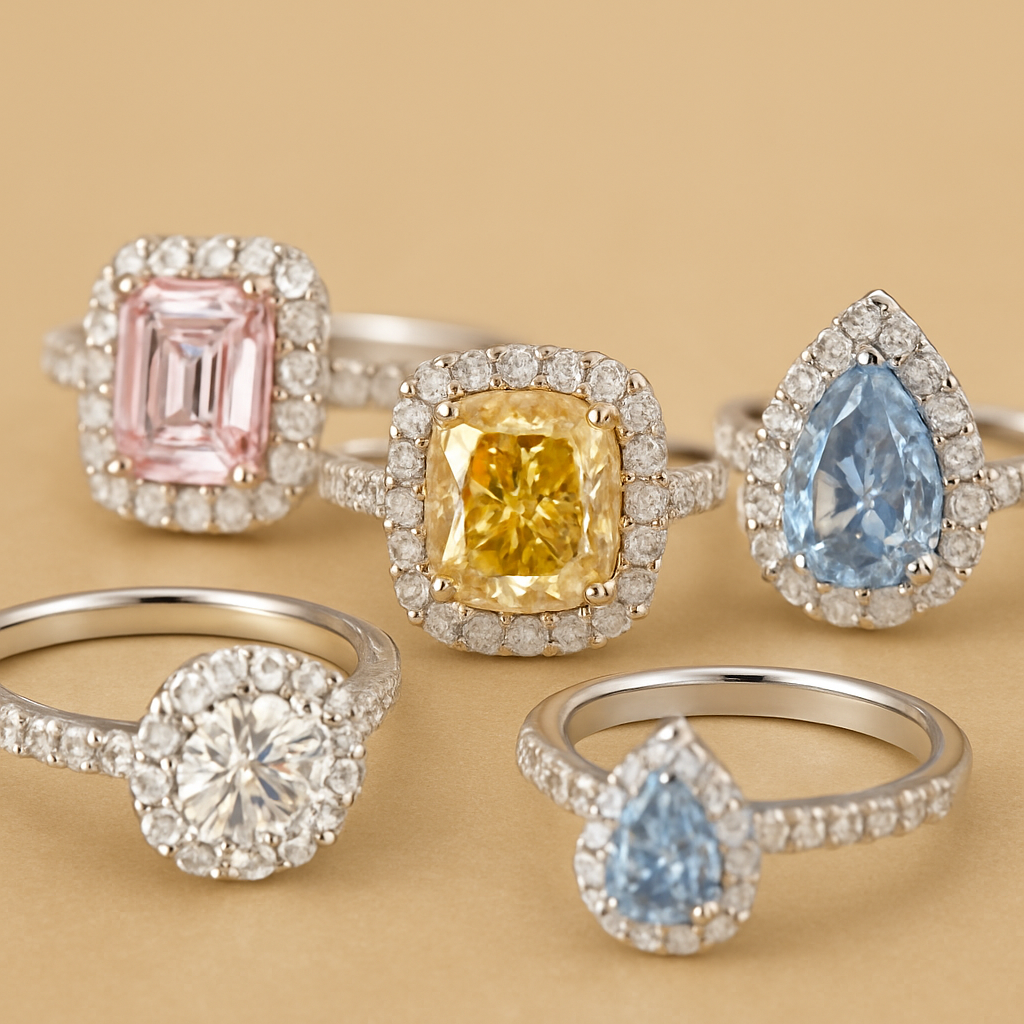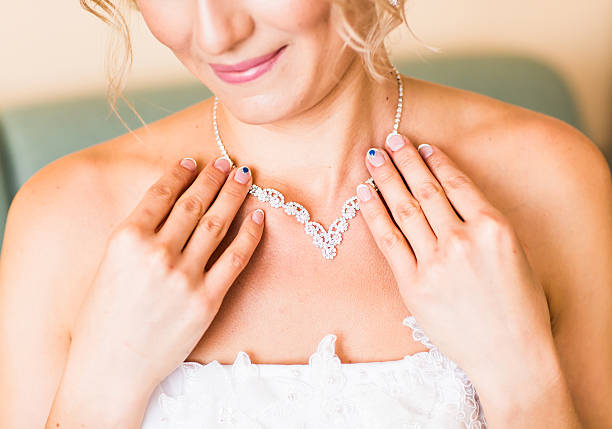Introduction to VS2 Lab Grown Diamonds
Lab-created diamonds are increasingly in demand as they are affordable, sustainable, and come with the ethical benefits that accompany them. Natural diamonds have always been seen as luxuries, but lab-created diamonds provide an equivalent, if not better, alternative. Lab-created diamonds are grown in controlled conditions that mimic the natural processes in which diamonds develop, through two primary methods: High Pressure High Temperature (HPHT) and Chemical Vapor Deposition (CVD).
The allure of lab-created diamonds is not just in their ethical creation but also in the quality that is attained. One of the most important factors that decide a diamond's overall look and worth is its clarity. Of the different grades of clarity, VS2 (Very Slightly Included 2) is a highly sought-after grade that offers the ideal balance between quality and price. Here in this guide, we will tell you all that you should know about VS2 lab-created diamonds, their attributes, advantages, and how to select the best one for your jewelry collection.
1. Understanding Diamond Clarity Grades
Clarity of diamond is among the Four Cs (Cut, Color, Clarity, Carat Weight) that are employed to assess the overall quality of a diamond. The clarity rating is derived from the presence of blemishes (surface imperfections) and inclusions (internal imperfections).
The clarity scale has multiple categories, and VS2 falls in the range of "Very Slightly Included." VS2 diamonds generally have inclusions that are very minute and cannot be seen except under magnification by a trained gemologist. They are generally not visible to the naked eye, and this is the reason VS2 diamonds are such a value.
The diamond clarity scale is:
- Flawless (FL): No inclusions or blemishes under 10x magnification.
- Internally Flawless (IF): No inclusions visible within the stone under 10x magnification.
- Very Very Slightly Included (VVS1, VVS2): Very hard to notice inclusions even under 10x magnification.
- Very Slightly Included (VS1, VS2): Inclusions under 10x magnification, but minor and difficult to detect by the naked eye.
- Slightly Included (SI1, SI2): Inclusions detectable by the naked eye.
- Included (I1, I2, I3): Inclusions impact transparency and brilliance.
- A VS2 diamond, in particular, boasts minute inclusions which are only visible when magnified, which is why it is an ideal option for people who desire a quality diamond at a lower cost.
2. Lab-Grown Diamonds vs Natural Diamonds: A Clear Comparison
Though lab-created diamonds have existed for several decades, they are now increasingly popular across the jewelry sector. Diamonds produced in a laboratory setting possess the same physical, chemical, and optical characteristics as natural diamonds but are produced in a lab rather than being extracted from the earth.
The Two Processes of Lab-Grown Diamond Production
1. High Pressure High Temperature (HPHT): It mimics nature's diamond-formation process using high heat and pressure to act upon carbon. It yields a chemically pure diamond just like natural diamonds.
2. Chemical Vapor Deposition (CVD): In this process, a mixture of gases, most commonly methane, is heated to produce carbon atoms that crystallize into diamond. CVD diamonds are chemically the same as natural diamonds and can be produced in a range of shapes and sizes.
The main distinction between lab-grown and natural diamonds lies in their origin and cost. Lab-grown diamonds tend to be 30-40% lower in price compared to natural diamonds, thus offering more value for money for consumers.
3. How VS2 Lab Grown Diamonds Are Evaluated
Gemological labs such as the Gemological Institute of America (GIA) or the International Gemological Institute (IGI) carefully grade lab-grown diamonds. These labs evaluate each diamond's clarity, cut, color, and carat weight using advanced tools and methods.
The inclusion in a VS2 diamond is typically tiny and situated in places that are not readily apparent. Clouds, feathers, and tiny crystals are typical inclusions in VS2 diamonds. These inclusions, which are frequently found close to the diamond's edges or bottom, do not lessen the diamond's overall beauty or brilliance. To make sure the grading is correct, a gemologist will examine each diamond closely.
The four key elements evaluated during grading are:
- Cut: This is a measure of how well the diamond has been cut and faceted. The cut affects how the diamond refracts light and affects its brilliance.
- Color: Lab diamonds are available in a range of colors, ranging from colorless (D) to light yellow or brown (Z). The closer to colorless, the more valuable the diamond.
- Clarity: As mentioned above, VS2 diamonds are in the "Very Slightly Included" category, so the inclusions are small and not easily seen.
- Carat Weight: This is the measurement of the diamond. The larger the diamond, the more it costs, but the cut quality, color, and clarity can contribute more to the overall value than size.
4. Benefits of Choosing a VS2 Lab Grown Diamond
There are a number of reasons to purchase a VS2 lab-grown diamond for your jewelry, and lab-grown diamonds, including those with a VS2 clarity rating, have a number of important benefits:
- Cost: Lab-grown diamonds, particularly those with a VS2 grade, cost about 30-40% less than a natural diamond. You can have a premium-quality diamond at a reduced price, enabling you to spend more on a higher carat size or an improved cut.
- Ethical and Sustainable: Lab-grown diamonds leave a much smaller environmental footprint than mined diamonds. Natural diamond mining has been associated with environmental degradation and human rights abuses, which lab-grown diamonds eradicate.
- High Quality: VS2 lab-created diamonds retain incredible clarity with only faint inclusions that are not detectable by the naked eye. This makes them a great option for anyone looking for a breathtakingly beautiful diamond without the steep price.
- Customization: Lab-created diamonds can be produced in particular shapes, sizes, and colors, offering consumers greater levels of customization.
5. How to Choose the Right VS2 Lab Grown Diamond

Selecting the ideal VS2 lab-created diamond involves taking into account a number of factors:
- Cut: Arguably the most critical factor in choosing a diamond is the cut. The higher the cut, the more brilliance and fire the diamond will have. For VS2 diamonds, an expertly cut diamond will conceal any minute inclusions and bring out the maximum natural beauty of the stone.
- Carat Weight: If you want a bigger diamond, the VS2 diamonds are one of your best options since they enable you to select a bigger stone while keeping good clarity at a lower cost.
- Shape: The shape of the diamond (such as round, oval, princess, cushion, emerald) contributes to how inclusions will be observed. Some shapes, such as the round brilliant cut, are very good at concealing inclusions, whereas others, such as the emerald cut, are able to highlight the clarity of the diamond more distinctly.
- Color: Although VS2 diamonds are an excellent choice in terms of clarity, color should also be taken into account. Choose a color grade that suits your taste and budget. In general, diamonds with a rating of D-F (colorless) will bring the most brilliance, but those with a rating of G-I (near colorless) are also very good value.
6. Common Myths About VS2 Lab Grown Diamonds
-
Myth 1: Diamonds grown in laboratories are not genuine diamonds
Fact: The physical and chemical makeup of lab-grown diamonds is the same as that of natural diamonds. They are genuine diamonds that were formed in a laboratory setting using the same crystal structure. -
Myth 2: VS2 diamonds are obviously flawed
Fact: A VS2 diamond's inclusions are so small that they are invisible to the unaided eye, guaranteeing a stunning appearance. -
Myth 3: Natural diamonds are superior to lab-grown diamonds
Fact: Lab-grown diamonds are just as good, if not better, in terms of quality and consistency than natural diamonds because they go through the same grading system and quality control.
7. Popular Shapes and Cuts for VS2 Lab Grown Diamonds
Take into account the following factors when selecting a shape for your VS2 lab-grown diamond:
- The most common diamond shape, round brilliant, is renowned for having the most sparkle and brilliance.
- Princess Cut: A square form that exhibits clarity and brilliant facets.
- Emerald Cut: A rectangular form that exhibits clarity through step cuts. Perfect for diamonds that are VS2.
- Oval, Cushion, and Asscher Cuts: These cuts provide a distinctive look while showcasing the VS2 diamonds' clarity and brilliance.
8. Caring for Your VS2 Lab Grown Diamond
To keep your VS2 lab-grown diamond looking beautiful and sparkling:
- Regular Cleaning: To clean your diamond, use a soft cloth and warm, soapy water. Steer clear of harsh chemicals that could harm the stone.
- Storage: To prevent scratches from other jewelry, keep your diamond in a jewelry box.
- Inspection: Have a qualified jeweler examine your diamond to make sure the setting is stable and there are no wear indicators.
9. Conclusion:
VS2 lab-grown diamonds offer a perfect combination of beauty, quality, and affordability. They provide all the advantages of natural diamonds, such as brilliance and elegance, but at a fraction of the price. Choosing a VS2 lab-grown diamond allows you to enjoy the same luxury without the ethical concerns or environmental impact of mined diamonds. Whether you’re buying an engagement ring, a pendant, or any other piece of fine jewelry, VS2 lab-grown diamonds are a fantastic option for those who want the best of both worlds.
At San Liora, we proudly offer a stunning collection of VS2 lab-grown diamonds that are ethically sourced, expertly crafted, and designed to celebrate your unique story. Each piece comes with a 12-month warranty and an appraisal certificate, ensuring you receive quality and peace of mind. Discover the brilliance and elegance of lab-grown diamonds with San Liora — where beauty meets responsibility.







